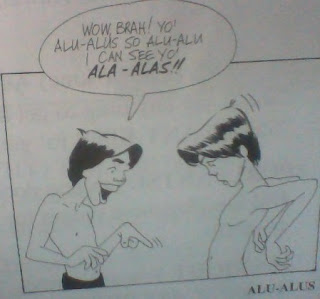Los Angeles, July 1980
During the 1960s and 1970s, no book would admit that gay people exist. At least, none on the shelves of the public library in my factory town, or my small private Lutheran college. I never saw the word "gay" in print. I saw "homosexual" once, in 1976, in a book on prisons.
The first time I saw the word "gay" in an actual book on a shelf in a bookstore: in 1980, when I was visiting my friend Tom in Los Angeles, and we stopped into a bookstore in Japantown. I bought Pidgin to the Max (1980), by Douglas Simonson, an illustrated dictionary of Hawaiian slang.
The slang was illustrated by humorous dialogues:
"Junior nice guy. He get ugly face, but."
"Laters wit' dat joke. Tired, but."
"Wow, dis binto so ono! Scoah, yeah?"
The humorous line drawings showed Hawaiian teenagers and young adults, often male, often cute.
Risque terms were included, including terms for male sex organs and butts: "Wow, brah! Yo' alu-alus so alu-alu I can see yo' ala-alas!"
Same sex desire appeared with some frequency. At a stoplight, a guy in a car gazes lustfully at the muscleman in the next lane, who responds: "I owe you money, o' wot?"
And The Word:
One of the entries was Mahu: "guys who like fool around with guys," that is, gay:
"No mess aroun' with dose mahus down Hotel Schtreet, brah! Dose buggahs radical."
That's all. But that was enough to break the silence in 1980.
See also: Wade the Beach Boy Cruises in Hawaii




Mahu really means a transvestite, but it's used these days to mean a bottom.
ReplyDeleteMahu does not mean transvestite. Mahu was very much an integral part of Hawaiian culture and not the negative stereotype (ie. transvestite) it is today. Often a young male within the household would assume female responsibilities (sorry for the sexist application), and even display effeminate characteristics. I remember Pidgin to Da Max, having attended and graduated high school in Hawaii c/o 1982.
ReplyDelete